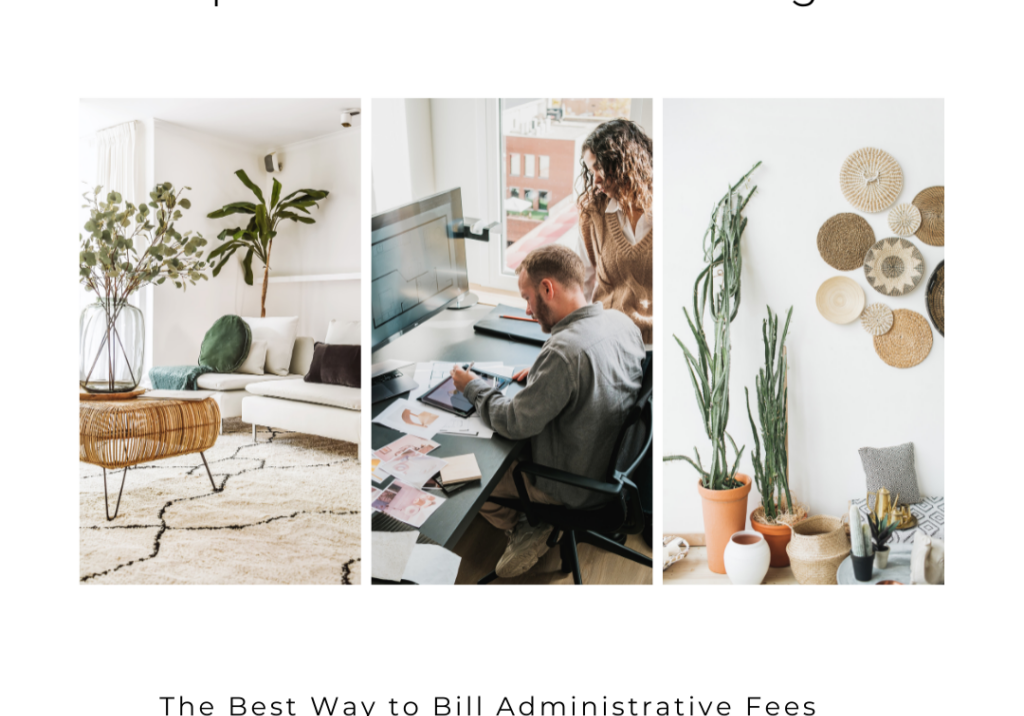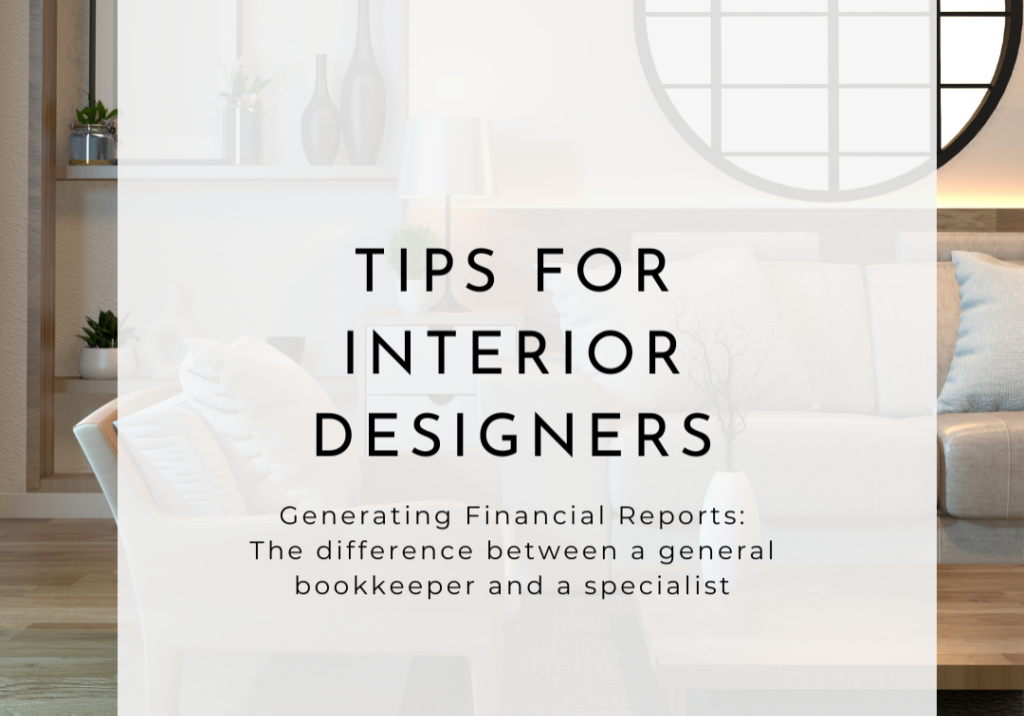How much do interior designers make? It’s a question that reflects the diverse nature of our industry, where income potential varies as much as the spaces we create. Whether you’re dreaming of starting your own firm or looking to grow your existing practice, understanding the financial side of design helps you build a business that matches your creative vision.
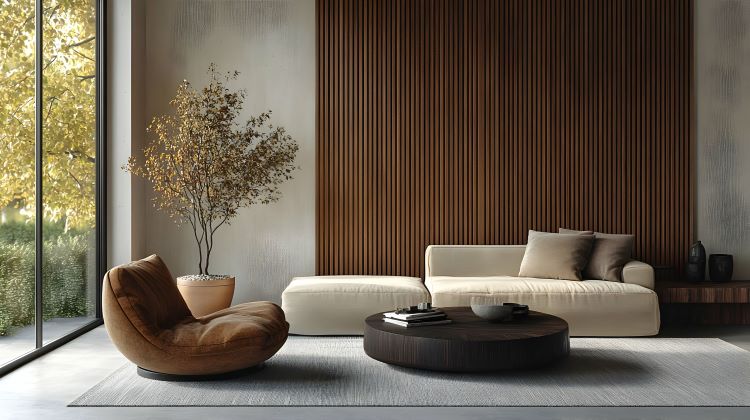
WHAT REALLY SHAPES DESIGNER INCOME?
The path to a profitable design business isn’t just about your portfolio or years of experience. Your income potential grows from a mix of smart business decisions, efficient systems, and strategic planning.
The key factors that influence your earning potential include:
- Your business model and service offerings
- Market location and target clients
- Experience level and specializations
- Project management efficiency
- Financial systems and tools
Breaking Down Designer Earnings
Most successful designers create multiple streams of income. This might look like:
Client Services:
- Design fees (hourly or flat-rate)
- Project management
- Consultation services
- Space planning
Product Revenue:
- Furniture and decor specification
- Custom piece commissions
- Material selections
- Procurement management
BREAKING INTO DESIGN: EARLY CAREER INCOME
Starting your design career brings exciting opportunities and, let’s be real, some financial uncertainty. Early-career designers typically build their income through a combination of firm experience and independent projects. While entry-level salaries vary significantly, most designers begin their careers at established firms, earning between $38,000-60,000 depending on location and firm size.
Understanding typical career progression in interior design helps set realistic income expectations and plan your professional growth. These benchmarks represent industry averages across different experience levels and business models:
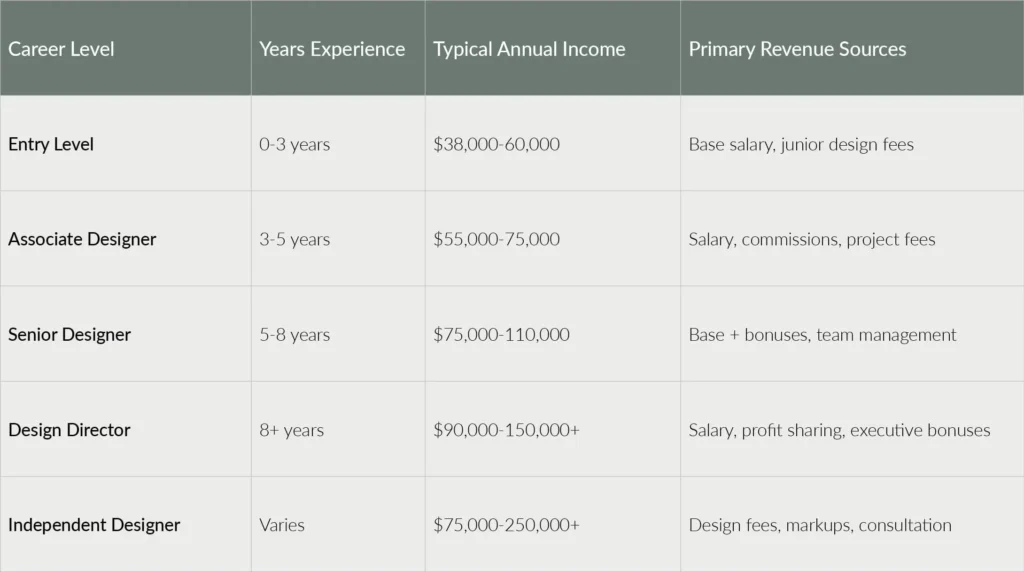
| Career Level | Years Experience | Typical Annual Income | Primary Revenue Sources |
| Entry Level | 0-3 years | $38,000-60,000 | Base salary, junior design fees |
| Associate Designer | 3-5 years | $55,000-75,000 | Salary, commissions, project fees |
| Senior Designer | 5-8 years | $75,000-110,000 | Base + bonuses, team management |
| Design Director | 8+ years | $90,000-150,000+ | Salary, profit sharing, executive bonuses |
| Independent Designer | Varies | $75,000-250,000+ | Design fees, markups, consultation |
Working with an established firm offers more than just a steady paycheck. Many designers find that early firm experience provides valuable insights into business operations, client management, and project execution – skills that prove invaluable whether you stay with a firm or eventually branch out independently.
Key benefits at this stage often include:
- Project bonuses and commissions
- Professional development opportunities
- Mentorship from senior designers
- Access to high-value projects
GROWING YOUR INCOME: MID-CAREER OPPORTUNITIES
With 3-5 years of experience, designers often find themselves at a crucial decision point: continue with a firm or branch out independently. Both paths offer unique financial opportunities and challenges worth considering.
Staying with a firm provides a clear progression path. Senior designers generally earn between $65,000-85,000, with opportunities to advance into team leadership and department management roles. These positions not only offer higher base salaries but often include profit-sharing and project bonuses that can significantly increase total compensation.
Starting an independent practice requires careful planning but offers unlimited potential. The first year usually focuses on building a client base while establishing efficient business systems. Working with CFO Services during this transition helps create a strong financial foundation for growth.
Second-year independent practitioners often see their gross revenue reach $75,000-150,000, provided they’ve established:
- A clear service structure
- Strong client relationships
- Efficient project management systems
- Professional financial practices
Building Long-Term Success
The key to sustained financial growth lies in creating scalable systems. Successful designers treat their business operations with the same attention to detail they bring to their design work. This means implementing professional bookkeeping practices, developing clear client communications, and regularly reviewing business performance.
SPECIALIZING FOR HIGHER INCOME
The path to higher earnings often involves finding your design niche. Just as every room tells a unique story, each specialization offers distinct financial opportunities. Luxury residential designers often command higher fees due to bigger budgets and more extensive projects. Meanwhile, commercial designers benefit from larger scale projects and repeat corporate clients.
Each design specialization offers unique income potential based on project scope, technical requirements, and market demand. Here’s how different specializations could compare:

| Specialization | Average Project Budget | Typical Fee Structure | Annual Income Potential |
| Residential | $50,000-250,000 | Hourly ($125-250) + 25-30% markup | $80,000-200,000 |
| Commercial | $200,000-2M+ | Fixed fee or % of project | $100,000-300,000 |
| Healthcare | $500,000-5M+ | Project % (8-15%) | $150,000-400,000 |
| Hospitality | $250,000-3M+ | Fixed fee + hourly overages | $120,000-350,000 |
| Sustainable Design | $100,000-1M+ | Hourly + certification fees | $90,000-250,000 |
Healthcare and hospitality design represent particularly lucrative specialties, demanding both specialized knowledge and commanding premium rates. These sectors value designers who understand their unique requirements and can deliver projects that balance aesthetics with strict functional requirements.
Top-earning specializations include:
- Luxury residential design
- High-end commercial projects
- Healthcare facility design
- Hospitality projects
- Sustainable design
MANAGING PROJECT PROFITABILITY
Understanding project economics transforms good designers into successful business owners. Working with integrated systems like Houzz Pro and QBO helps track both creative and financial aspects of each project. This visibility into project performance allows you to make informed decisions about which types of projects to pursue.
Profitable projects typically share several characteristics:
- Clear scope definition
- Appropriate budget allocation
- Efficient procurement processes
- Strong client communication
- Regular progress monitoring
Financial Systems That Support Growth
While creativity drives our passion, proper financial systems ensure our businesses thrive. This means implementing professional practices for:
- Billing and Collections
Your billing strategy should support both cash flow and client relationships. Consider milestone payments that align with project phases, ensuring steady income throughout longer projects. Many successful designers require deposits of 30-50% before beginning work, protecting both their time and business resources.
- Project Cost Management
Understanding and controlling project costs directly impacts profitability. This involves:
- Creating detailed project budgets
- Tracking actual vs. estimated costs
- Managing procurement timing
- Monitoring markup margins
REGIONAL MARKET IMPACT ON DESIGNER INCOME
Your location massively influences your earning potential in interior design. While talent and experience matter, market dynamics play a crucial role in what you can charge. Major design hubs like New York, Los Angeles, and Miami naturally command higher rates, but they also come with higher operating costs.
Secondary markets offer unique opportunities. Cities with growing luxury markets or strong commercial development often provide an ideal balance of project availability and competitive rates. Areas experiencing population growth or economic development typically see increased demand for design services.
Design service rates vary significantly by market type and location:
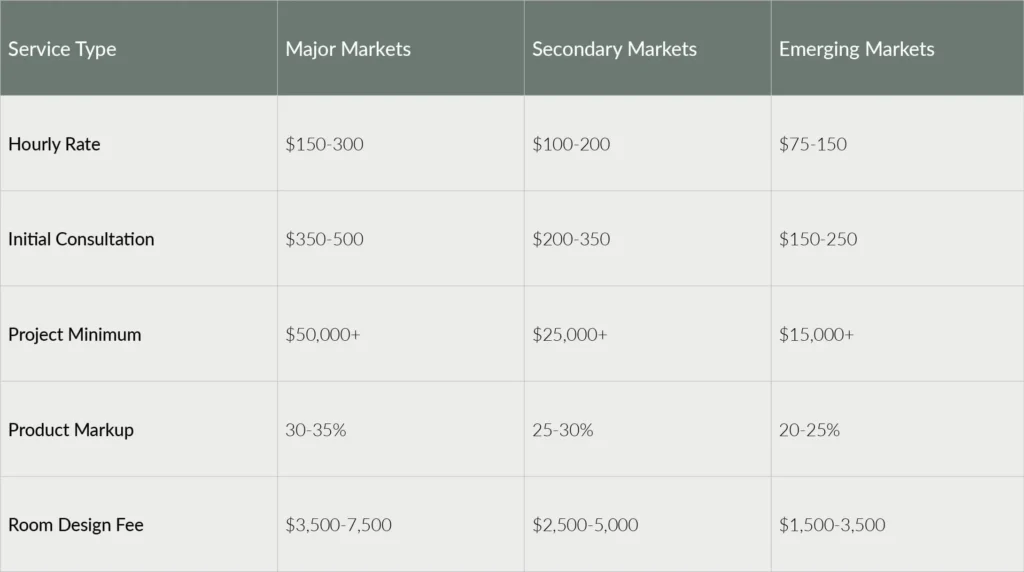
| Service Type | Major Markets | Secondary Markets | Emerging Markets |
| Hourly Rate | $150-300 | $100-200 | $75-150 |
| Initial Consultation | $350-500 | $200-350 | $150-250 |
| Project Minimum | $50,000+ | $25,000+ | $15,000+ |
| Product Markup | 30-35% | 25-30% | 20-25% |
| Room Design Fee | $3,500-7,500 | $2,500-5,000 | $1,500-3,500 |
Market-specific factors that impact earnings include:
- Local cost of living
- Luxury market presence
- Commercial development activity
- Competition levels
- Client demographics
EMPLOYMENT MODELS AND EARNING POTENTIAL
The way you structure your design business significantly impacts your income potential. While traditional employment offers stability, independent practice provides greater control and earning potential. Many successful designers create hybrid models, combining steady firm work with select independent projects.
- Firm Employment
Working with an established firm provides valuable benefits beyond salary. Professional development, established client bases, and structured advancement paths offer clear growth opportunities. Large firms often provide:
- Comprehensive benefits packages
- Regular salary reviews
- Performance bonuses
- Professional development budgets
- Independent Practice
Running your own design business requires more initial investment but offers unlimited earning potential. Success depends on:
- Creating efficient systems, maintaining strong client relationships, and managing projects effectively.
- Many independent designers start with CFO Services to establish proper financial foundations and scale strategically.
STRATEGIC NETWORKING FOR INCOME GROWTH
Professional relationships often lead to higher-value projects and referrals. Building a strong network isn’t just about attending industry events – it’s about creating meaningful connections with vendors, contractors, architects, and other design professionals. These relationships often lead to collaborative projects that increase both creative scope and income potential.
Local showrooms and design centers frequently become valuable networking hubs. Building strong relationships with vendors not only improves procurement efficiency but often leads to preferred pricing and early access to new collections. These advantages directly impact your bottom line.
Your professional network should include:
- Real estate professionals who understand luxury properties
- Architects focused on high-end projects
- Custom furniture makers and artisans
- Project photographers
- Industry-specific service providers
BUILDING PROFESSIONAL VALUE
Increasing your earning potential means continuously enhancing your professional value. While creativity and technical skills form your foundation, business acumen and industry certifications often justify higher rates.
- Professional Development
Advanced certifications and specialized training demonstrate expertise to high-value clients. Consider focusing on:
- Sustainable design certifications
- Project management qualifications
- Technical specializations like lighting design
- Business management education
PROJECT SCOPE AND PRICING STRATEGY
Understanding project scope and pricing appropriately represents a crucial skill for maximizing income. Large projects don’t automatically mean higher profits – sometimes smaller, well-scoped projects prove more profitable.
The key lies in understanding your time investment and resource allocation for each project type. Using tools like Houzz Pro helps track project metrics accurately, informing future pricing decisions. Consider factors beyond just square footage:
- Project complexity
- Client decision-making style
- Resource requirements
- Timeline constraints
OVERCOMING INCOME CHALLENGES
Every design business faces obstacles on the path to higher income. Understanding common challenges helps you prepare effective solutions before issues arise.
Project Delays and Cash Flow
Project delays can significantly impact cash flow – a challenge particularly common in design businesses. Protect your income by:
- Setting clear payment schedules aligned with project milestones
- Maintaining cash reserves for unexpected delays
- Diversifying your client base to spread risk U
- sing professional tools to track payments and expenses
Market Fluctuations
Design businesses often feel the impact of economic changes early. Building resilience means:
- Creating multiple income streams
- Developing both residential and commercial expertise
- Maintaining strong vendor relationships
- Building a financial buffer for slower periods
Client Relationship Management
Challenging client relationships can affect both project profitability and your professional reputation. Address this by:
- Establishing clear communication channels
- Setting explicit expectations early
- Documenting all decisions and changes
- Creating professional yet friendly boundaries
TAKING YOUR DESIGN INCOME TO THE NEXT LEVEL
Growing your design income requires both strategic planning and practical action. Whether you’re just starting or looking to scale your existing practice, focus on building sustainable systems that support long-term growth.
Professional Support Systems
As your business grows, consider partnering with financial professionals who understand the unique aspects of design businesses. CFO Services tailored to creative professionals can help optimize your business structure and identify growth opportunities. Regular consultation with tax professionals ensures compliance with IRS requirements while maximizing allowable deductions.
Technology Integration
Modern design businesses benefit from integrated technology solutions. Combining project management tools like Houzz Pro with financial management systems creates efficient workflows that support growth. This integration helps:
- Track project profitability
- Manage vendor relationships
- Streamline client communications
- Monitor business performance
YOUR NEXT STEPS TO HIGHER INCOME
Ready to increase your design business income? Start with these action items:
- Review Your Current Position
- Take an honest look at your business model, pricing structure, and market position.
- Identify areas where you can increase value or improve efficiency.
Based on your market analysis and business goals, create a clear plan for growth. This might include:
- Expanding into new market segments
- Adding complementary services
- Building strategic partnerships
- Enhancing your professional credentials
TRANSFORM YOUR DESIGN INCOME
Our team specializes in helping designers build profitable, sustainable businesses. Whether you’re just starting out or looking to scale your existing practice, contact us to learn how we can help optimize your financial systems and grow your design business. We’ll work together to create a strategy that matches your creative vision with sound business practices.
FAQs
What is the average starting salary for interior designers?
Entry-level designers typically earn between $38,000-45,000 annually at firms, while independent designers’ income varies based on project acquisition and market.
How long does it take to reach six figures as an interior designer?
Most designers reach six-figure incomes within 5-7 years of starting their practice, provided they have efficient systems and strong client relationships.
Should I charge hourly or flat rate for design projects?
Most successful designers use both: flat rates for full projects and hourly rates for consultations or smaller services.
What percentage markup should I charge on products?
Standard industry markup ranges from 20-35% on products, with luxury firms sometimes charging higher percentages.
Do commercial or residential projects pay better?
Commercial projects often offer larger budgets and steady work, but residential projects typically allow for higher percentage markups and more creative freedom.
How much should I charge for initial consultations?
Initial consultations range from $150-500, depending on your market and experience level.
When should I consider raising my rates?
Raise rates annually to account for inflation, or when you’ve gained significant experience, additional certifications, or your demand exceeds capacity.
What certifications increase earning potential?
NCIDQ certification, LEED accreditation, and specializations in healthcare or commercial design often command higher rates.
How do location and market affect designer income?
Major design hubs like New York or Los Angeles command higher rates but have higher operating costs. Growing secondary markets often offer good income potential with lower overhead.
What’s the fastest way to increase design income?
Focus on efficient project management, implement professional financial systems, and develop strong vendor relationships for better product margins.
Share On:

